2001 NISSAN FRONTIER child seat
[x] Cancel search: child seatPage 1 of 290
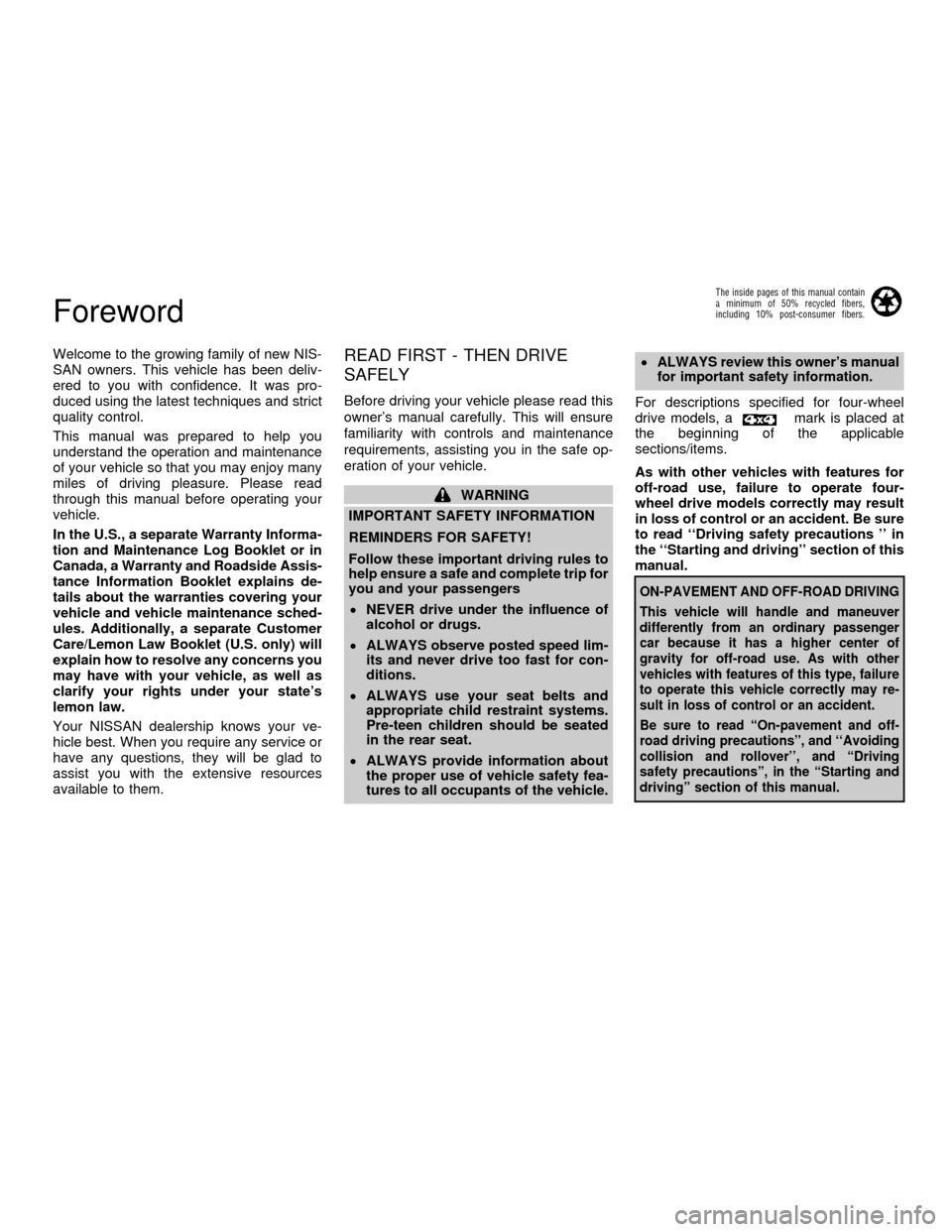
Welcome to the growing family of new NIS-
SAN owners. This vehicle has been deliv-
ered to you with confidence. It was pro-
duced using the latest techniques and strict
quality control.
This manual was prepared to help you
understand the operation and maintenance
of your vehicle so that you may enjoy many
miles of driving pleasure. Please read
through this manual before operating your
vehicle.
In the U.S., a separate Warranty Informa-
tion and Maintenance Log Booklet or in
Canada, a Warranty and Roadside Assis-
tance Information Booklet explains de-
tails about the warranties covering your
vehicle and vehicle maintenance sched-
ules. Additionally, a separate Customer
Care/Lemon Law Booklet (U.S. only) will
explain how to resolve any concerns you
may have with your vehicle, as well as
clarify your rights under your state's
lemon law.
Your NISSAN dealership knows your ve-
hicle best. When you require any service or
have any questions, they will be glad to
assist you with the extensive resources
available to them.READ FIRST - THEN DRIVE
SAFELY
Before driving your vehicle please read this
owner's manual carefully. This will ensure
familiarity with controls and maintenance
requirements, assisting you in the safe op-
eration of your vehicle.
WARNING
IMPORTANT SAFETY INFORMATION
REMINDERS FOR SAFETY!
Follow these important driving rules to
help ensure a safe and complete trip for
you and your passengers
²NEVER drive under the influence of
alcohol or drugs.
²ALWAYS observe posted speed lim-
its and never drive too fast for con-
ditions.
²ALWAYS use your seat belts and
appropriate child restraint systems.
Pre-teen children should be seated
in the rear seat.
²ALWAYS provide information about
the proper use of vehicle safety fea-
tures to all occupants of the vehicle.²
ALWAYS review this owner's manual
for important safety information.
For descriptions specified for four-wheel
drive models, amark is placed at
the beginning of the applicable
sections/items.
As with other vehicles with features for
off-road use, failure to operate four-
wheel drive models correctly may result
in loss of control or an accident. Be sure
to read ``Driving safety precautions '' in
the ``Starting and driving'' section of this
manual.
ON-PAVEMENT AND OFF-ROAD DRIVING
This vehicle will handle and maneuver
differently from an ordinary passenger
car because it has a higher center of
gravity for off-road use. As with other
vehicles with features of this type, failure
to operate this vehicle correctly may re-
sult in loss of control or an accident.
Be sure to read ªOn-pavement and off-
road driving precautionsº, and ``Avoiding
collision and rollover'', and ªDriving
safety precautionsº, in the ªStarting and
drivingº section of this manual.
The inside pages of this manual contain
a minimum of 50% recycled fibers,
including 10% post-consumer fibers.
Foreword
ZX
Page 8 of 290

1 Seats, restraints and supplemental air
bag systems
Front bucket seats..................................................1-2
Seat adjustment ................................................1-2
Tilting front bucket seat (if so equipped)...........1-3
Front 60/40 bench seats ........................................1-4
Seat adjustment ................................................1-4
Tilting front 60/40 bench seat (King Cab
models only) ......................................................1-5
Front bench seat ....................................................1-6
Seat adjustment ................................................1-6
Tilting front bench seat ......................................1-7
Tilting rear bench seat (Crew Cab
models only) ......................................................1-7
Jump seats .............................................................1-8
Head restraint adjustment ......................................1-9
Supplemental restraint system .............................1-10
Precautions on supplemental restraint
system .............................................................1-10
Passenger supplemental air bag on/off
switch and light (except Crew Cab
models) ............................................................1-17
Supplemental air bag warning labels ..............1-20
Supplemental air bag warning light .................1-20Seat belts .............................................................1-22
Precautions on seat belt usage ......................1-22
Child safety ......................................................1-23
Pregnant women .............................................1-25
Injured persons ................................................1-25
Three-point type seat belt with retractor .........1-25
Two-point type seat belt without
retractor (center of 60/40 bench seat) ............1-28
Two-point type seat belt without
retractor (jump seat and center of
bench seat) ......................................................1-29
Seat belt extenders .........................................1-31
Seat belt maintenance ....................................1-31
Child restraints .....................................................1-32
Precautions on child restraints ........................1-32
Installation on rear bench seat center
position (Crew Cab models only) ....................1-34
Installation on rear bench seat outboard
positions (Crew Cab models only) ..................1-36
Top tether strap child restraint ........................1-41
Installation on front passenger seat ................1-42
ZX
Page 13 of 290
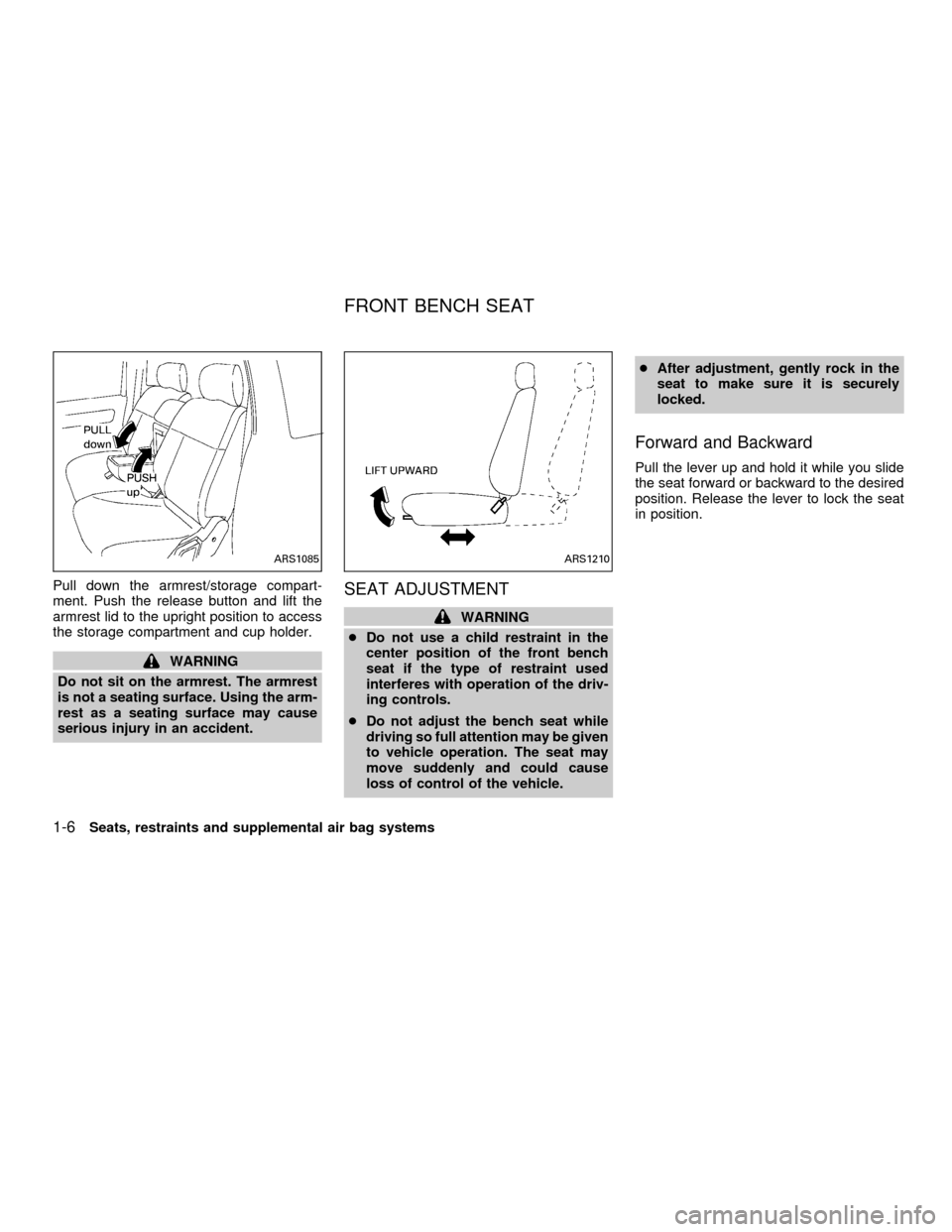
Pull down the armrest/storage compart-
ment. Push the release button and lift the
armrest lid to the upright position to access
the storage compartment and cup holder.
WARNING
Do not sit on the armrest. The armrest
is not a seating surface. Using the arm-
rest as a seating surface may cause
serious injury in an accident.
SEAT ADJUSTMENT
WARNING
cDo not use a child restraint in the
center position of the front bench
seat if the type of restraint used
interferes with operation of the driv-
ing controls.
cDo not adjust the bench seat while
driving so full attention may be given
to vehicle operation. The seat may
move suddenly and could cause
loss of control of the vehicle.cAfter adjustment, gently rock in the
seat to make sure it is securely
locked.
Forward and Backward
Pull the lever up and hold it while you slide
the seat forward or backward to the desired
position. Release the lever to lock the seat
in position.
ARS1085ARS1210
FRONT BENCH SEAT
1-6Seats, restraints and supplemental air bag systems
ZX
Page 15 of 290
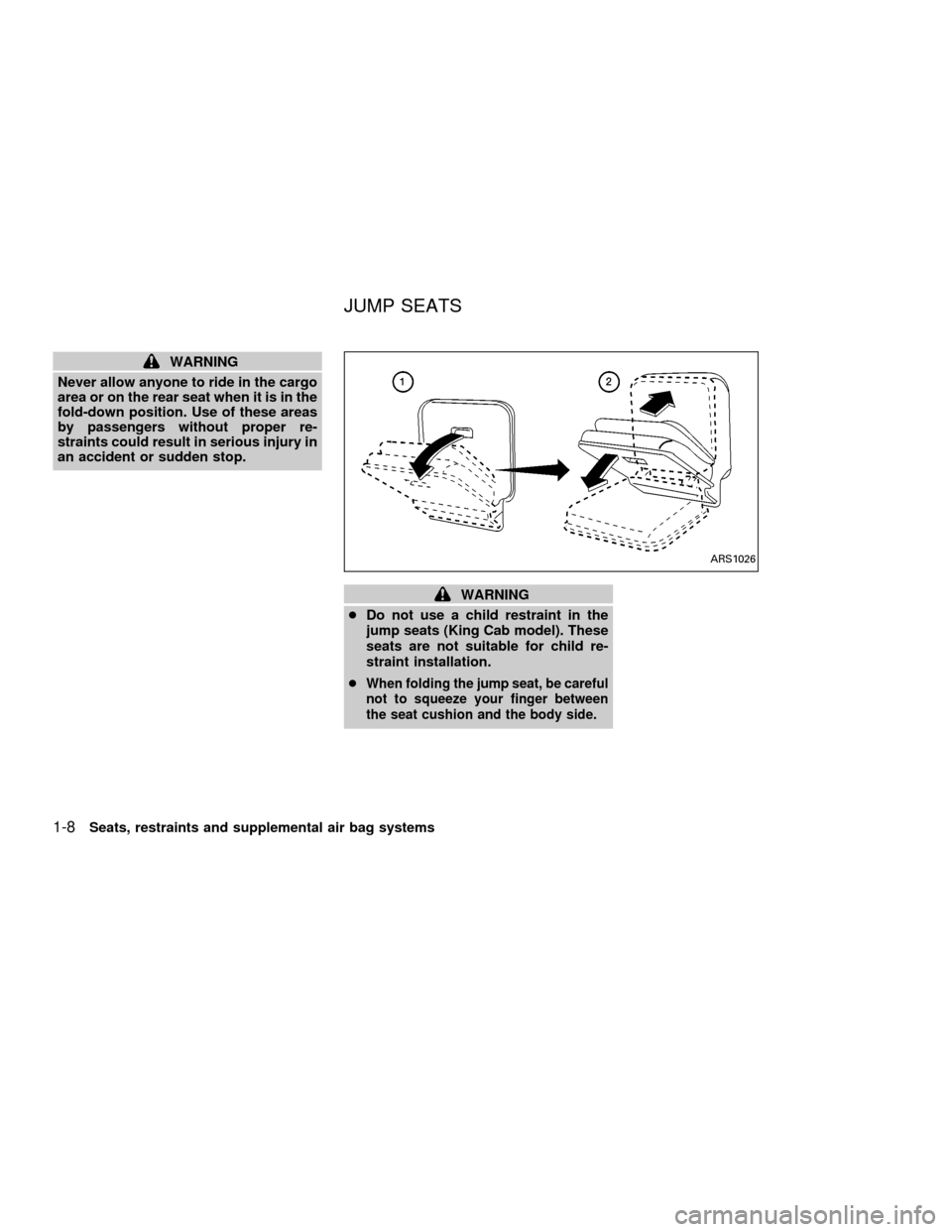
WARNING
Never allow anyone to ride in the cargo
area or on the rear seat when it is in the
fold-down position. Use of these areas
by passengers without proper re-
straints could result in serious injury in
an accident or sudden stop.
WARNING
cDo not use a child restraint in the
jump seats (King Cab model). These
seats are not suitable for child re-
straint installation.
c
When folding the jump seat, be careful
not to squeeze your finger between
the seat cushion and the body side.
ARS1026
JUMP SEATS
1-8Seats, restraints and supplemental air bag systems
ZX
Page 20 of 290
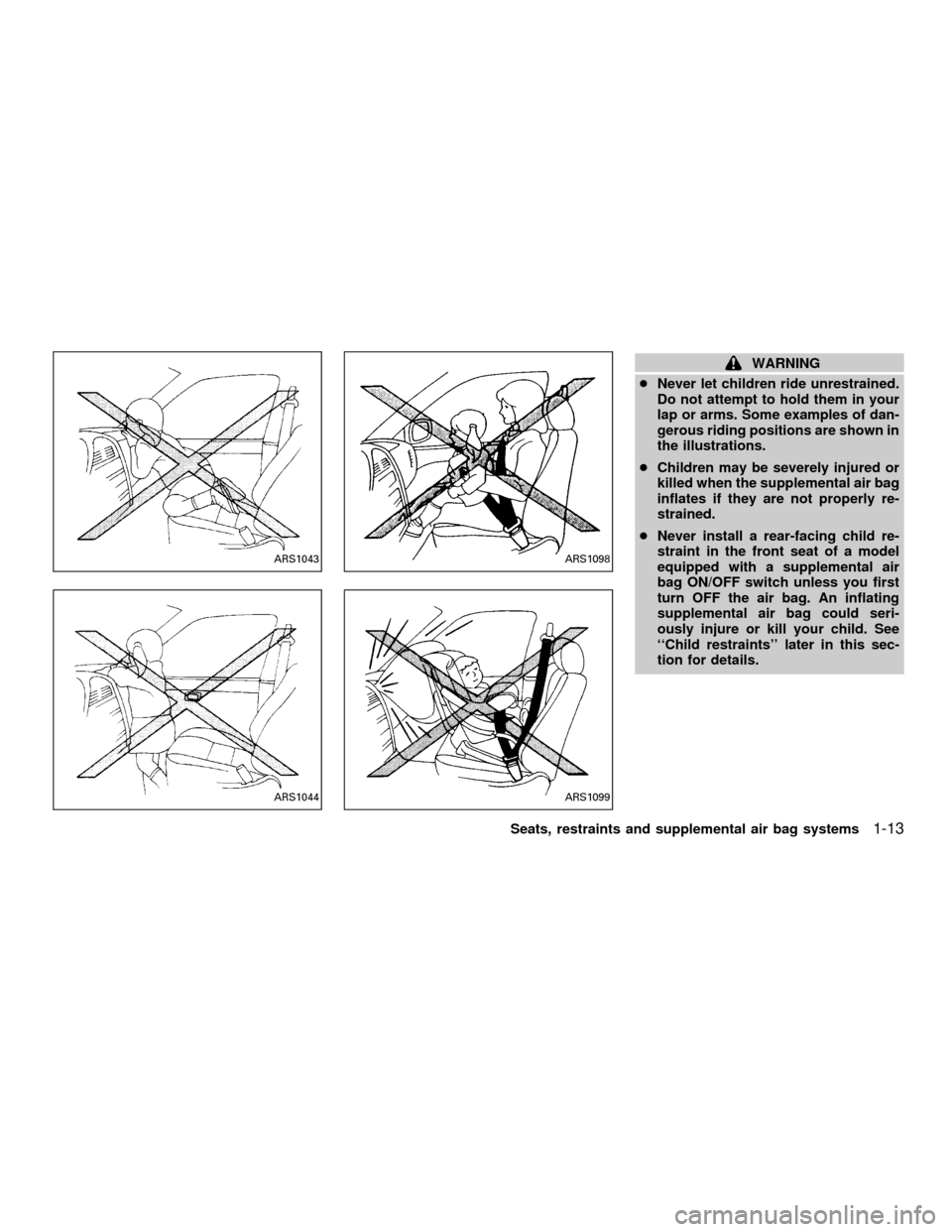
WARNING
cNever let children ride unrestrained.
Do not attempt to hold them in your
lap or arms. Some examples of dan-
gerous riding positions are shown in
the illustrations.
cChildren may be severely injured or
killed when the supplemental air bag
inflates if they are not properly re-
strained.
cNever install a rear-facing child re-
straint in the front seat of a model
equipped with a supplemental air
bag ON/OFF switch unless you first
turn OFF the air bag. An inflating
supplemental air bag could seri-
ously injure or kill your child. See
``Child restraints'' later in this sec-
tion for details.
ARS1043
ARS1044
ARS1098
ARS1099
Seats, restraints and supplemental air bag systems1-13
ZX
Page 21 of 290

Supplemental air bag system
The driver supplemental air bag is located in
the center of the steering wheel. The passen-
ger supplemental air bag is located in the top
right section of the instrument panel.
These systems are designed to meet optional
certification requirements under U.S. regula-
tions. They are also permitted in Canada. The
optional certification allows air bags to be
designed to inflate somewhat less forcefully
than previously.However, all of the infor-mation, cautions and warnings in this
manual still apply and must be followed.
The supplemental air bag system is designed
to inflate in higher severity frontal collisions,
although it may inflate if the forces in another
type of collision are similar to those of a higher
severity frontal impact. It may not inflate in
certain frontal collisions. Vehicle damage (or
lack of it) is not always an indication of proper
supplemental air bag system operation.
The front passenger supplemental air bag is
equipped with an ON/OFF switch (except
crew cab models which have a rear seat for
child restraint installation). Because no rear
seat exists where a rear facing child restraint
can be secured in other models, the switch is
designed to turn OFF the passenger supple-
mental air bag so that a rear facing child
restraint can be used in the front passenger
seat. See ``Passenger supplemental air bag
ON/OFF switch and light'' later in this section
for details.
When the supplemental air bag inflates, a
fairly loud noise may be heard, followed by
the release of smoke. This smoke is not
harmful and does not indicate a fire, but
care should be taken not to intentionally
inhale it, as it may cause irritation and
WRS0059
1-14Seats, restraints and supplemental air bag systems
ZX
Page 25 of 290
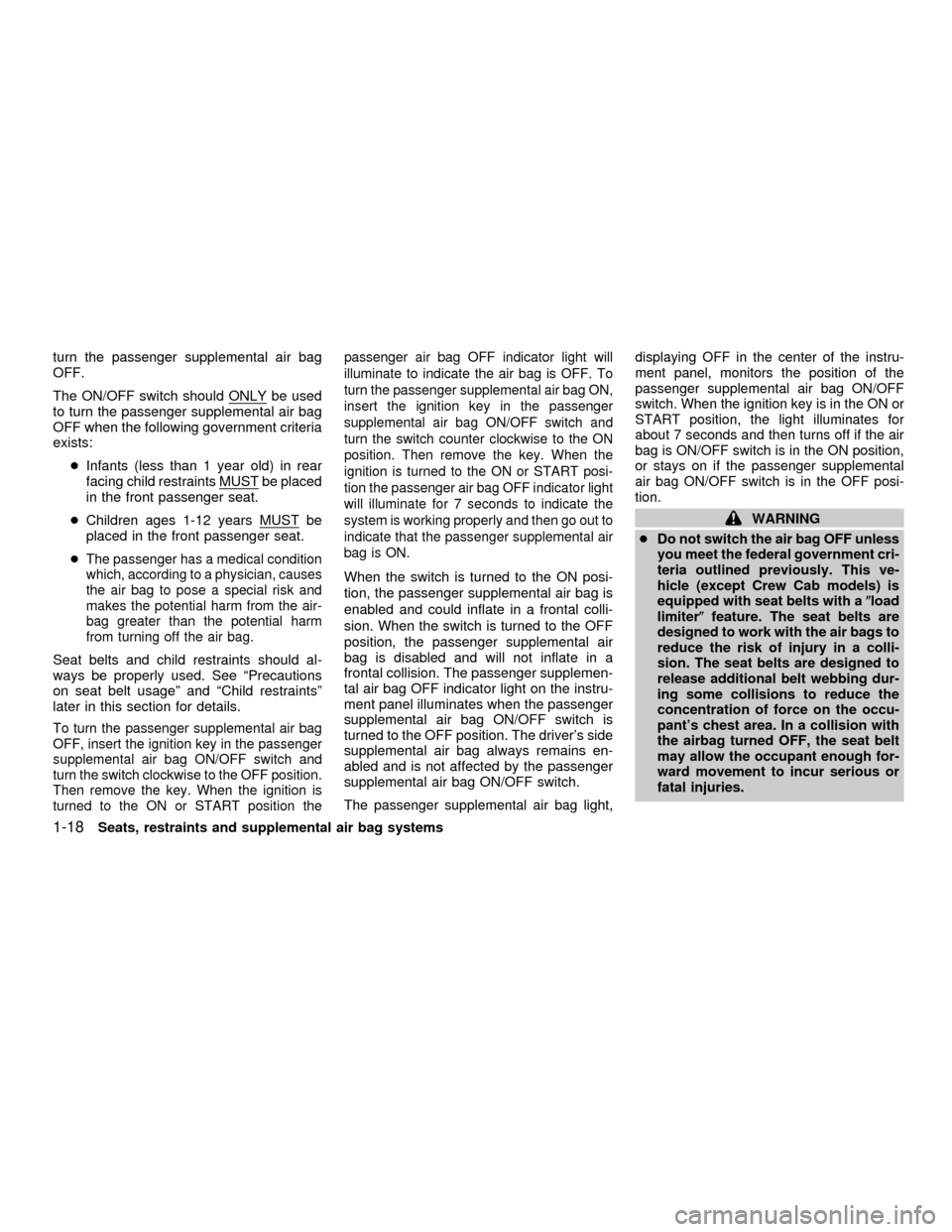
turn the passenger supplemental air bag
OFF.
The ON/OFF switch should ONLY
be used
to turn the passenger supplemental air bag
OFF when the following government criteria
exists:
cInfants (less than 1 year old) in rear
facing child restraints MUST
be placed
in the front passenger seat.
cChildren ages 1-12 years MUST
be
placed in the front passenger seat.
c
The passenger has a medical condition
which, according to a physician, causes
the air bag to pose a special risk and
makes the potential harm from the air-
bag greater than the potential harm
from turning off the air bag.
Seat belts and child restraints should al-
ways be properly used. See ªPrecautions
on seat belt usageº and ªChild restraintsº
later in this section for details.
To turn the passenger supplemental air bag
OFF, insert the ignition key in the passenger
supplemental air bag ON/OFF switch and
turn the switch clockwise to the OFF position.
Then remove the key. When the ignition is
turned to the ON or START position thepassenger air bag OFF indicator light will
illuminate to indicate the air bag is OFF. To
turn the passenger supplemental air bag ON,
insert the ignition key in the passenger
supplemental air bag ON/OFF switch and
turn the switch counter clockwise to the ON
position. Then remove the key. When the
ignition is turned to the ON or START posi-
tion the passenger air bag OFF indicator light
will illuminate for 7 seconds to indicate the
system is working properly and then go out to
indicate that the passenger supplemental air
bag is ON.
When the switch is turned to the ON posi-
tion, the passenger supplemental air bag is
enabled and could inflate in a frontal colli-
sion. When the switch is turned to the OFF
position, the passenger supplemental air
bag is disabled and will not inflate in a
frontal collision. The passenger supplemen-
tal air bag OFF indicator light on the instru-
ment panel illuminates when the passenger
supplemental air bag ON/OFF switch is
turned to the OFF position. The driver's side
supplemental air bag always remains en-
abled and is not affected by the passenger
supplemental air bag ON/OFF switch.
The passenger supplemental air bag light,displaying OFF in the center of the instru-
ment panel, monitors the position of the
passenger supplemental air bag ON/OFF
switch. When the ignition key is in the ON or
START position, the light illuminates for
about 7 seconds and then turns off if the air
bag is ON/OFF switch is in the ON position,
or stays on if the passenger supplemental
air bag ON/OFF switch is in the OFF posi-
tion.
WARNING
cDo not switch the air bag OFF unless
you meet the federal government cri-
teria outlined previously. This ve-
hicle (except Crew Cab models) is
equipped with seat belts with a(load
limiter(feature. The seat belts are
designed to work with the air bags to
reduce the risk of injury in a colli-
sion. The seat belts are designed to
release additional belt webbing dur-
ing some collisions to reduce the
concentration of force on the occu-
pant's chest area. In a collision with
the airbag turned OFF, the seat belt
may allow the occupant enough for-
ward movement to incur serious or
fatal injuries.
1-18Seats, restraints and supplemental air bag systems
ZX
Page 26 of 290
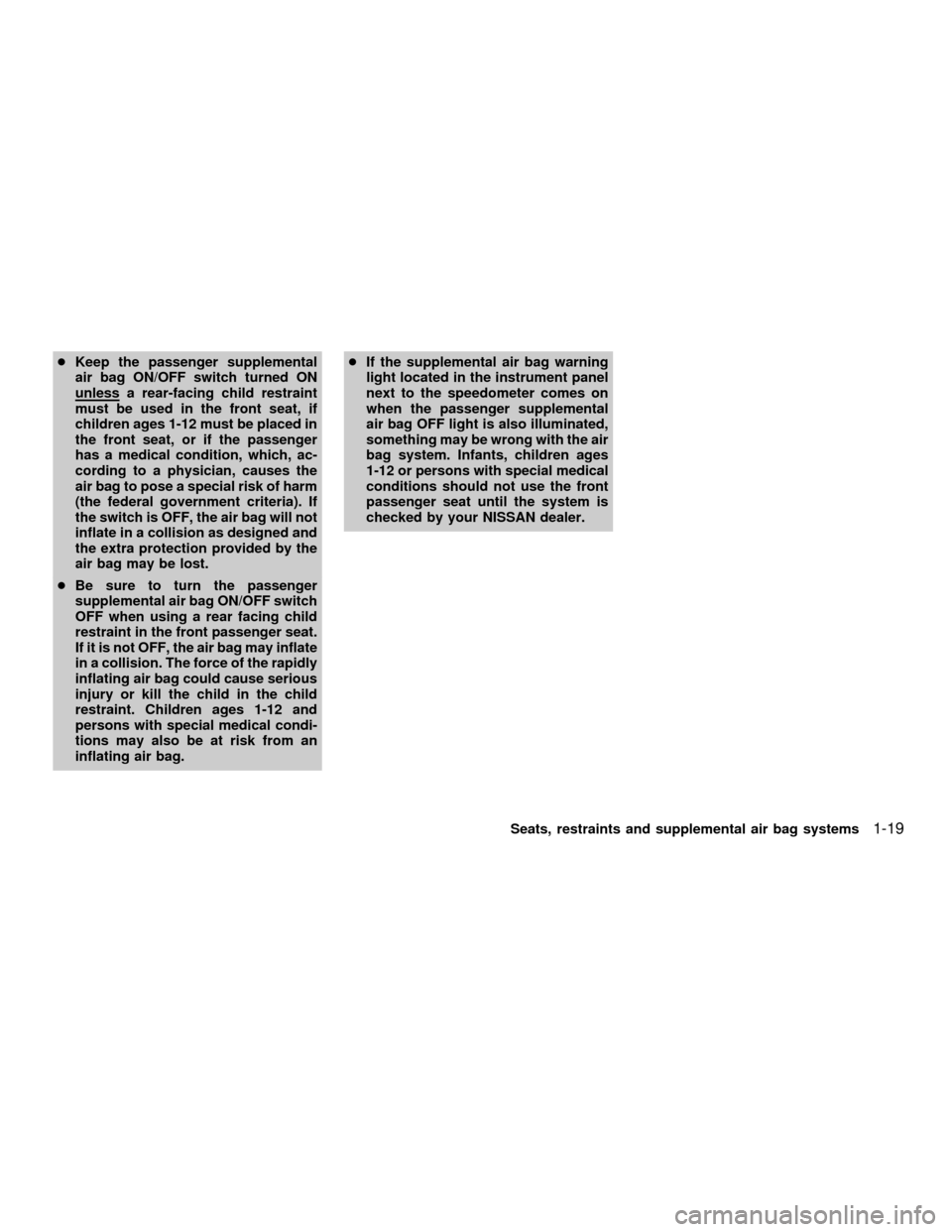
cKeep the passenger supplemental
air bag ON/OFF switch turned ON
unless
a rear-facing child restraint
must be used in the front seat, if
children ages 1-12 must be placed in
the front seat, or if the passenger
has a medical condition, which, ac-
cording to a physician, causes the
air bag to pose a special risk of harm
(the federal government criteria). If
the switch is OFF, the air bag will not
inflate in a collision as designed and
the extra protection provided by the
air bag may be lost.
cBe sure to turn the passenger
supplemental air bag ON/OFF switch
OFF when using a rear facing child
restraint in the front passenger seat.
If it is not OFF, the air bag may inflate
in a collision. The force of the rapidly
inflating air bag could cause serious
injury or kill the child in the child
restraint. Children ages 1-12 and
persons with special medical condi-
tions may also be at risk from an
inflating air bag.cIf the supplemental air bag warning
light located in the instrument panel
next to the speedometer comes on
when the passenger supplemental
air bag OFF light is also illuminated,
something may be wrong with the air
bag system. Infants, children ages
1-12 or persons with special medical
conditions should not use the front
passenger seat until the system is
checked by your NISSAN dealer.
Seats, restraints and supplemental air bag systems
1-19
ZX